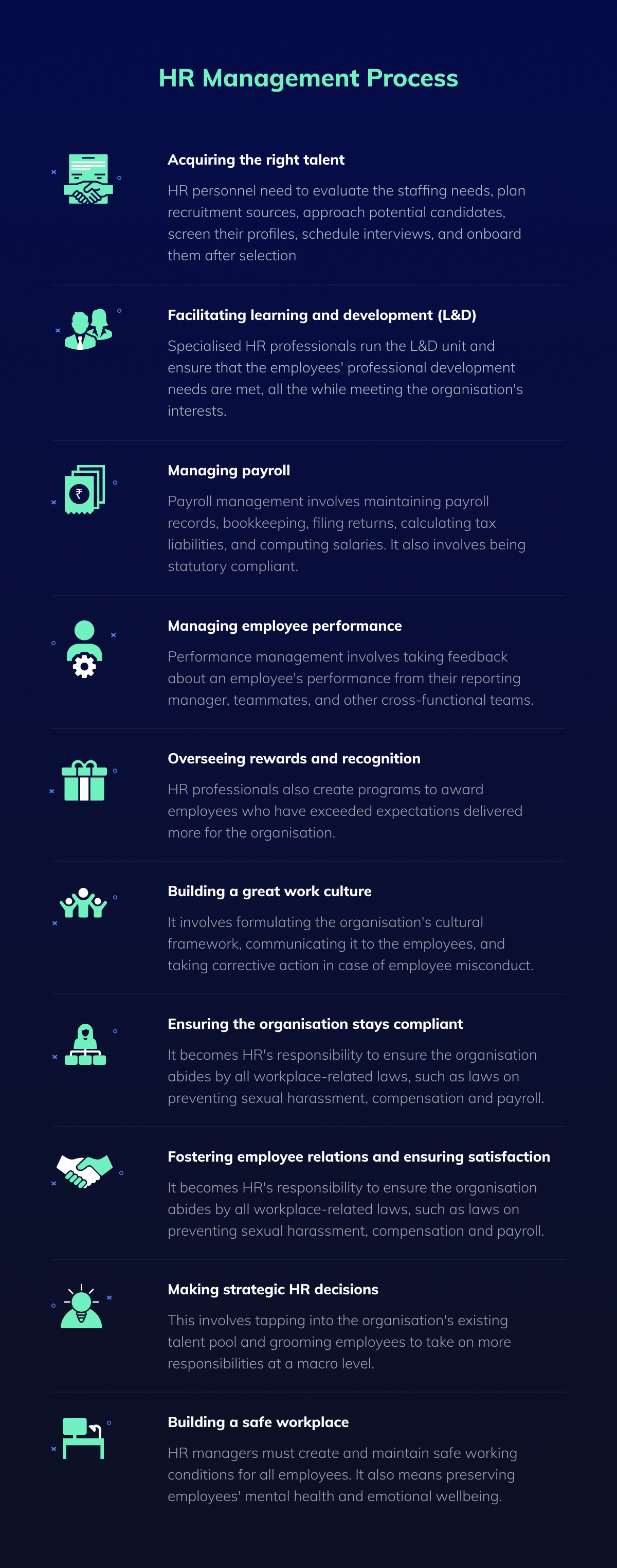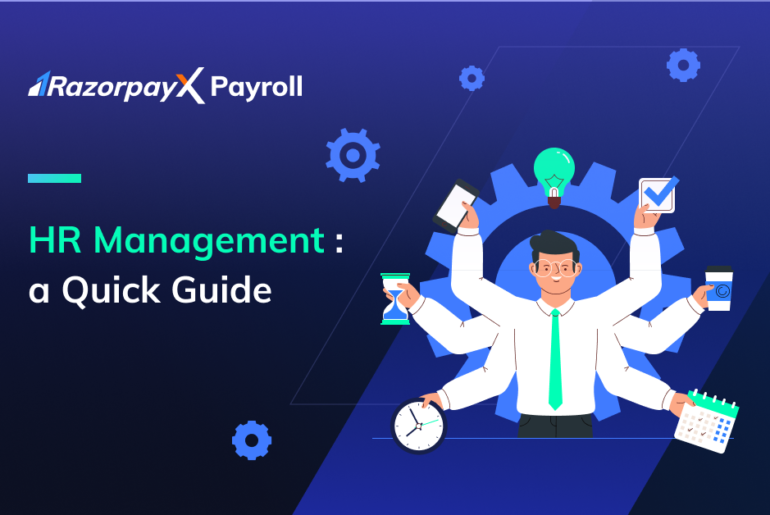Table of Contents
What is Human Resource Management: A Quick Guide
Human resource management, or HR management, is vital to any organisation – simply because it involves handling human capital, an organisation’s most powerful resource. The HR department is responsible not just for hiring the right people but also for ensuring that they are engaged, adequately compensated, well looked after, and aligned with the culture and values of the organisation.
Human resource management – definition and functions
Human Resource Management (HRM) involves hiring, training, retaining, and engaging the organisation’s workforce. HRM aligns employees’ professional goals with overall business objectives and ensures that their talents are effectively utilised.
To do that, the HR department charts out learning and development initiatives, employee engagement programs, and workplace policy awareness events, among other things. HR folks are also actively involved in the (super-cumbersome) process of managing payroll and statutory compliances.
For startups especially, human resource management is more than just a vital function. More often than not, a well-managed workforce is what differentiates a successful startup from one that is struggling to stay afloat.
Human resource management: the process
Here’s what human resource management entails.

1. Acquiring the right talent
Hiring the right people is the prime responsibility of talent acquisition specialists, who are an integral part of the HR machinery of an organisation. They do it by :
-
- evaluating the staffing needs
- planning recruitment sources
- approaching potential candidates
- screening their profiles
- scheduling interviews, and
- onboarding them after selection.
For startups, in particular, hiring is a critical task. In their initial years, startups have much smaller teams compared to large organisations. But, these early-stage employees are crucial, as they wear many hats and can make or break the organisation. Human resource management in general and talent acquisition in particular thus become very important for startups.
2. Facilitating learning and development (L&D)
Behind every great organisational achievement are highly skilled employees. And, behind every highly skilled employee is a well-run Learning and Development (L&D) unit.
The learning and development unit is run by specialised HR professionals who ensure that the employees’ professional development needs are taken care of, while meeting the organisation’s interests.
Usually, learning and development happen on the job and through seminars, conferences, organisation-sponsored courses and tie-ups. It may also happen off the job, wherein the employee goes to another location – such as a university or another branch or division of the organisation – for training.
3. Managing payroll
Perhaps the most important function of human resource management is handling payroll. Payroll management typically involves maintaining payroll records, bookkeeping, filing returns, calculating tax liabilities, and computing salaries. It also involves ensuring that the business stays compliant with all applicable compensation-related laws of the country.
Creating a payroll framework requires HR professionals to look into:
- wages
- salaries
- bonuses
- overtime payments
- increments
- tax deductions
- health insurance
- post-retirement packages and other benefits
Managing payroll is quite an uphill task for most organisations, especially if they process it manually using excel sheets. On the other hand, products like RazorpayX Payroll automate payroll and compliance end-to-end, making the whole process a 10-minute affair.
4. Managing employee performance
HR professionals must ensure that employees perform to the best of their abilities and assess their performance against pre-determined standards. This is called performance management.
Performance management is a joint exercise by HR professionals and the reporting managers of the employees being assessed. The process involves taking feedback about an employee’s performance from their reporting manager, teammates, and anyone else they regularly collaborate with. This is popularly known as 360-degree appraisal.
The outcome of the exercise tells the HR professional whether the employee is performing above, below or at par with the standards set. If an employee’s job performance is subpar, HR executives and the reporting manager try to understand why that is the case and plan corrective action accordingly.
On the other hand, if the employee’s performance is at par with or better than the pre-determined standards, they are rewarded with performance-based incentives such as bonuses.
5. Overseeing rewards and recognition
In line with the previous point, HR professionals also create programs to recognise employees who have given the organisation more than what was expected of them. The rewards given to employees as part of these programs can be monetary or non-monetary.
Monetary rewards include pay hikes, bonuses, and sometimes even ESOPs, while non-monetary rewards include perks, promotions, or other growth opportunities. Both of these help the organisation satisfy and retain its hard-acquired talent.
Read more: The Complete Guide to ESOPs
6. Building a great work culture
The work culture of an organisation acts as a talent magnet if it is great, and a talent repellent if it is poor. And, the onus of fostering a great work culture lies on the HR department. HR executives regularly conduct events to ensure that all employees are educated on the cultural values that the organisation swears by and how they should be reflected in each employee’s work.
HR managers are responsible for formulating the organisation’s cultural framework, communicating it to the employees, and taking corrective action in case of employee misconduct.
7. Ensuring the organisation stays compliant
Compliance is the top priority of the HR department. The organisation must abide by all workplace-related laws, such as laws on the prevention of sexual harassment, compensation and payroll, fair recruitment and termination. Lapses on the compliance front could translate into the organisation being exposed to the possibility of getting sued.
HR managers are also required to stay up to date on the latest amendments and changes in these laws, and organise conferences and training sessions for employees to bring them up to speed and ensure that the organisation stays compliant.
Payroll compliance, in particular, is a significant challenge for HR professionals since it involves complex calculations on bulky excel sheets. Most organisations do it manually, making the process even more time consuming and error-prone.
8. Fostering employee relations and ensuring satisfaction
Employees should trust HR folks enough to come to them in times of need, and should feel safe and well looked after at the workplace. This is why HR managers must build and maintain solid relationships with employees.
HR executives organise outreach programs, informal talk sessions, employee wellness programs, and engagement activities to cement employee relations and boost job satisfaction. They also conduct feedback surveys to understand how they can make the workplace better.
Another part of this function is to help employees resolve conflicts and disputes between teams, individual employees, or between employees and the organisation. HR professionals are required to navigate such situations with great tact and ensure that amicable settlements are arrived at for the benefit of all parties involved.
9. Making strategic HR decisions
Hiring people, training them, and putting them to work in the short run is not enough. Long-term success for the organisation warrants an effective human resource management and succession planning strategy. Creating such strategies and making decisions based on them is called strategic human resource management (SHRM).
At a macro level, strategic human resource management would involve tapping into the organisation’s existing talent pool and grooming employees to take on more responsibilities. It would also include exploring avenues to acquire the right people to occupy positions of strategic importance in the organisation, especially when the organisation is growing.
At a micro level, it would involve formulating policies around workplace diversity and inclusion, compensation, and time-off. The purpose of these policies is not just to have a well-balanced workforce but also to score points on the employer branding front, which ensures a steady supply of top talent for the organisation and keeps attrition in check.
10. Building a safe workplace
Gone are the days when job-seekers, desperate to land any role in an organisation, would consent to working in an unsafe working environment. Even a remotely unsafe working environment (excluding commonly known and accepted occupational hazards) is enough to scare potential and existing employees away.
The highest priority of HR managers is to create and maintain safe working conditions for employees. Safety does not just mean protection from the possibility of physical harm but also the preservation of employees’ mental health and emotional wellbeing.
Policies made for employee safety include guidelines for preventing sexual harassment, emergency evacuation procedures, and standard operating procedures for ensuring physical safety at the workplace.
India’s most loved payroll & HR management software
RazorpayX Payroll is a simple yet powerful human resource management software that helps you manage employees across their lifecycle, from onboarding to exit management with the full and final settlement. It lets you manage leaves, attendance, and reimbursements, all from a single dashboard.
The software handles all payroll payments and filings of compliances like TDS, PF, ESI, and PT. It also lets your employees access their accounts, where they can easily declare investments, view/download payslips, apply for leaves, etc.
What’s more – RazorpayX Payroll also let you insure your employees, and even integrates with your favourite workspace app, Slack.
So, if you’ve been looking for an efficient human resource management software solution that takes care of everything from generating offer letters, tracking attendance, and managing reimbursements to all your payroll and compliance woes and insuring your employees, then your search ends here.
FAQs
1. What are the 5 main areas of HR Management?
The five main areas of HR Management include employee recruitment & onboarding, training & development, compliance management, employee engagement & satisfaction, building a safe workplace.
2. What are the 4 HR management processes?
The four major HR management processes are recruitment & onboarding, training & development, payroll compliance management, and managing employee performance.
3. What is the most important in HRM?
The main HRM goal at any company is to help the company grow and increase its bottom line. The HR team archives that by leading activities such as recruitment & onboarding, strategic planning, managing employee performance & compensation, and training & development.
4. Is payroll a HR function?
In India, payroll processing is done by HR department by collaborating with the finance team. When employees have any questions or concerns about their salary, they usually approach the HR team.
5. How is HR payroll calculated?
Various steps involved in calculating payroll are, preparation of list of employees to be paid, defining your payroll policy, gathering and validating employee inputs, calculating payroll i.e., net pay calculations after adjusting necessary deductions & taxes, disbursing employee salaries, paying statutory dues, and distributing payslips and tax computation sheets.





